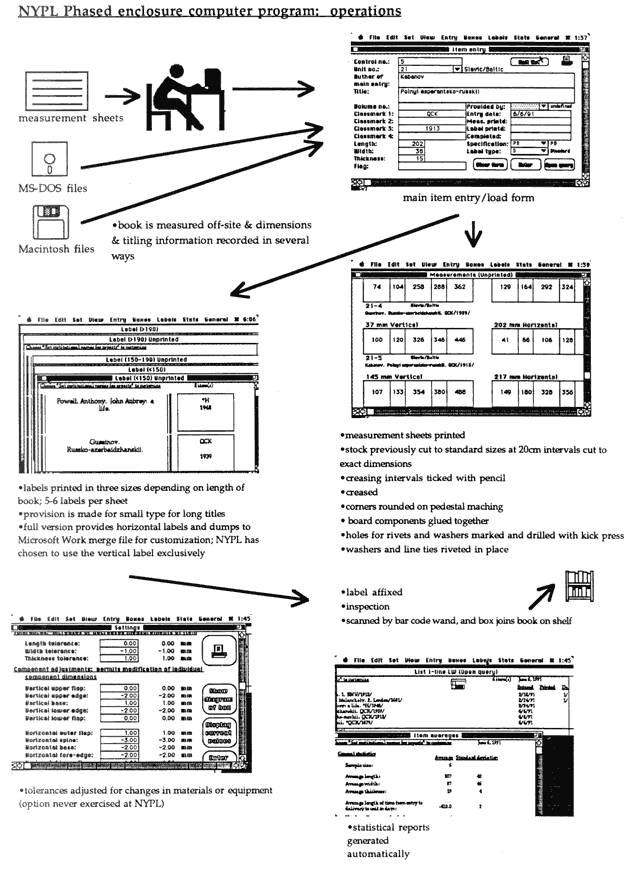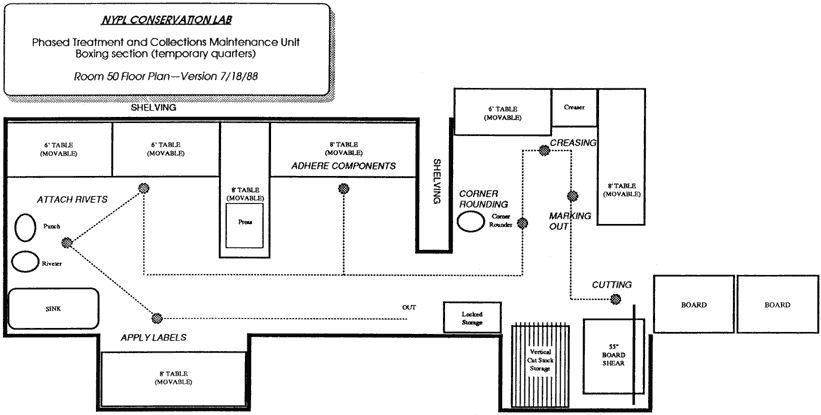Collections Maintenance Activities at the New York Public Library, Research Libraries
by Jo Anne Martinez and Marc ReevesThe Institution and its Collections
The New York Public Library is the second largest research library (after the Library of Congress) in the United States. According to the Library's 1989-1990 statistical report, the non-circulating collections are estimated at 35 million catalogued items, including 6 million bound volumes, 35,000 scrapbooks, 20 million manuscripts, 3 million pictures and photographs, 1 million programs and playbills, 385,000 maps, and 35,000 posters. There are four research library centers: the Humanities and Social Sciences Center (the Central Research Library), the Performing Arts Research Center at Lincoln Center, the Schomburg Center for Research in Black Culture, and the new Science and Business library to be located in the old B. Altman building on 34th Street. Additional collections are housed at the 43rd Street Annex.
Phased Treatment and Collections Maintenance Unit
The Phased Treatment and Collections Maintenance Unit (PT/CMU) of the Conservation Lab was formed in 1988 as an attempt to deal with preservation needs in two areas: 1) treatment and protection of low-use artifactual or semi-artifactual material in the non-circulating general stacks of the Research Libraries; 2) repair requirements of heavily-used open shelf reference materials. Each year the unit produces 17,000 phased boxes and other types of enclosures using two to four staff members. in addition, the unit reviews, inspects, and coordinates all commercial rebinding performed for NYPL. an in-house rapid repair and recasing capability is under development in order to achieve faster turn-around time and more suitable repair and rebinding specifications than are currently available commercially.
The Phased Treatment and Collections Maintenance Unit will also participate in the Conservation Lab's Macintosh-based comprehensive selection and specification computer program, designed to provide rapid processing of various preservation options (see graphic). a number of the automated specification "modules" are presently in operation: phased boxing, commercial rebinding specification and tracking, and microfilming processing. the modules have now been combined into an integrated program with provision for conducting all selection (including access to bibliographic utilities), specification, and processing while in the stacks. One step shelf-to-shipment or shelf-to-camera processing is anticipated, along with the capacity to specify and then perform the treatment or other preservation options at a later date, presumably after funding is secured.
Organization and Staffing
The Conservation Division of the New York Public Library is comprised of four offices with a total staff of eighty-seven: the Shelf and Binding Preparation Office, the Preservation Microfilming Office, the Preservation Microfilming Lab, and the Conservation Laboratory. the PT/CMU is part of the Conservation Laboratory, which has a total staff level of nineteen, including five graduate-trained conservators. PT/CMU has a staff of six. the fabrication of enclosures is performed by four hourly-paid positions, typically filled by persons with no prior training in conservation. Two remaining permanent positions in the unit are filled at the Conservation Technician level (one to three years of experience) and at the Assistant Conservator level (graduate education in conservation or equivalent).
Although the budget of PT/CMU is separate, materials are shared between all sections of the Conservation Lab. the personnel of the Conservation Lab cooperate on many large projects such as disaster recovery, processing of large batches of contractual work, and the shipping and receiving of items. Training of staff primarily takes place in-house.
Philosophy of Treatment
The priorities of the PT/CMU for low use items incorporate standardized specifications and minimum intervention. Minor repair and protective enclosure are emphasized. the priority for high use reference items is on heavy duty recasing and quick turn-around time.
Work Flow
The Phased Treatment and Collections Maintenance Unit treats items from all 25 divisions of the library. Items are brought to the attention of divisional conservation representatives by various means: when the item is requested by a user, through review of the shelves when a representative is gathering items for a meeting, when another staff member calls attention to an item, when items are transferred between divisions, and when items enter the collection. in addition, many newly acquired items arrive with conservation problems. Treatment projects comprised of items of similar treatment specification (in contrast to item-by-item selection) are encouraged.
Routine collection maintenance work enters the unit through regular appointments the representatives may make with the head of PT/CMU every other week. Each item is accompanied by a form. the conservation representatives may recommend treatment for an item and discuss any questions they may have at the meeting. Divisional quotas have been established limiting both the total number of items treated and those which can receive rush service.
The phased boxing program provides protective enclosure for a large number of items while the items remain on the shelf. Divisional staff enters measurement and bibliographic data into either a DOS or Macintosh database or spreadsheet, and forwards the disk to Conservation. From this data, box dimensions and labels are automatically generated by our Macintosh computer. Phased boxes and four flap folders with labels are constructed for the items in approximately one week. Items too large to be fabricated in-house are ordered from a contractual vendor (presently items taller than 18"). This computer program is provided on request to other institutions without charge.
Specifications
- heavy duty recases - stamped labels
- recases retaining original covers
- tip ins of six leaves or less - indexes, addenda, mutilations
- leaf repair - mutilation, fold-out materials
- non-aqueous deacidification - encapsulation
- pamphlet binders - items sewn in standard phased boxes
- four flap folders - 12 standard sizes
Figures
Fig. 1
Fig. 2
Fig. 3
History of Repair Function at NYPL
The NYPL Bindery began operation in 1913 with a staff of seventy, two years after the library opened. All binding and "collections maintenance" was performed by this unit. the Library began using contractual library binders during the 1950's and closed the bindery in the late 1970's through staff attrition and transfer. the Shelf and Binding Preparation Office in Conservation Division now coordinates the binding of newly acquired items with commercial binders.
Jo Anne MartinezHead, Phased Treatment and Collections Maintenance Unit
Marc Reeves
Head, Conservation Lab
New York Public Library
Publication History
Received: Fall 1992
This paper is one of the institutional profiles offered by participants in the Library Collections Conservation Discussion Group at the the Book and Paper specialty group session, AIC 20th Annual Meeting, June 2-7, 1992, Buffalo, NY.
Papers for the specialty group session are selected by committee, based on abstracts and there has been no further peer review. Papers are received by the compiler in the Fall following the meeting and the author is welcome to make revisions, minor or major.


